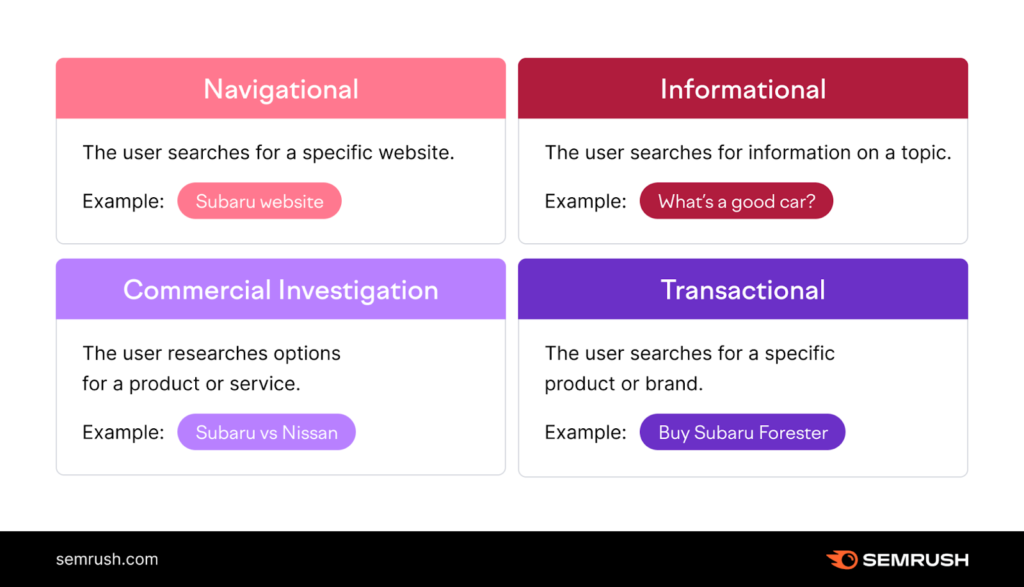About Keyword Intent Mapping
Keyword intent mapping is a crucial strategy in the world of Search Engine Optimization (SEO) that involves aligning website content with the user’s search intent. This process goes beyond simple keyword research, delving into the ‘why’ behind a search query.
Understanding the intent behind keywords allows marketers and SEO professionals to craft content that meets the users’ needs more effectively, potentially increasing the website’s visibility on search engine results pages (SERPs), improving engagement, and enhancing the overall user experience. Keyword intent mapping is not just about attracting more traffic but about attracting the right kind of traffic that is more likely to convert.
Understanding Different Types of Keyword Intent

Image Credits - Semrush
- Informational Intent
Such queries mostly start with “how to,” “what is,” “why does,” etc., i.e., queries of intention to look for information or knowledge.
- Navigational Intent
This intent is when users are looking for a specific website or page. They already have a destination in mind and use the search engine to find it.
- Transactional Intent
The transactional intents belong to the user who is ready to make some purchase or perform an activity that could convert into a transaction. The keywords might involve some brands or product names coupled with some buying signals, like “buy,” “deal,” or “discount.”
- Commercial Intent
This user is a bit of a purchaser, because he will be actually visiting in order to compare and read reviews. They’re in the decision-making phase but not yet ready to buy.
Each intent type, therefore, calls for a different content strategy to best meet the users’ needs. So, clear understanding of these differences is very essential in mapping the keyword intent.
How do you identify the search intent of a keyword?
— James Reynolds (@FollowJames) April 2, 2024
Easy!
Drop the keyword into Google and see what's ranking.
Google knows what searchers want better than anyone else.
Attempting to rank your pages without checking intent first?
It is a complete and utter waste of time.
The Importance of Keyword Intent Mapping in SEO Strategy
Keyword intent mapping is very important in an SEO strategy since it has the capability to make sure that ranking content definitely aligns with what searchers are looking for, hence having an excellent chance for clicks, engagement, and conversion. As earlier said, it helps the business better draw guidelines to create content and improves satisfaction from the user, hence deriving better results for the efforts on SEO made.
How to Conduct Keyword Intent Mapping

Keyword intent mapping is a detailed process of analyzing and mapping to your content strategy the underlying intent behind search queries pertaining to your business or the content domain. That is something you should do by looking at various tools to help in the process:
- Researching and Categorizing Keywords
First and foremost, put up an exhaustive list of keywords relating to the business or content in question. This is very necessary as it will help in understanding the wide scope of user intent from your offerings.
- Google Keyword Planner: This is an important tool for any search engine optimizer, helping to find ideas relating to keywords and give you the search volume for the particular keyword. This may help you to break down categorization on the areas where a keyword would belong based on its likely intent.
- AnswerThePublic: It is an extremely helpful tool serving the questions that users ask around some given keywords and surfacing them, finding the informational intent keywords by serving the queries in a visual.
- Identifying Intent
Now, after the list is prepared, one has to classify them according to the kind of intent the word represents. This is one more job that you might need to do manually, but some tools would help you do this easily.
- SEMrush: SEMrush offers a Keyword Magic Tool and Keyword Overview, giving the value in keywords by factors such as difficulty, search volume, and consideration of the keyword within SERP features. It is one of the tools that classified keywords into “buckets” to make it clear which intent they serve.
- Ahrefs: Ahrefs has its Keywords Explorer in which it offers insights on ranking difficulty, volume, and clicks data per keyword. This might help deduce intent by looking at what ranks at the moment.
- Matching Content to Keyword Intent
Structure your keywords and, thereafter, your content so that it helps in meeting the multiple intents identified. This may very well mean either creating new content that fits the intent or repurposing existing content to respond in a way more suitable to that intent.
- Moz Keyword Explorer: Use the SERP Analysis feature by Moz to get the nature of content ranking when you use a particular keyword. This will be able to guide you in making your content search intent similar to it.
- Utilizing Tools for Efficiency
Efficiency in keyword intent mapping, therefore, does not just come from identification and categorization but the check on how the content correlates with the user’s intent and the subsequent optimization to be so.
- Google Analytics: It helps one gauge performance on the content according to the different intents, such as analyzing the bounce rates, session duration, and the conversion rates. This can enable a person to do even better in honing the content strategy in order to meet user expectations.
- BuzzSumo: Use BuzzSumo to look up content that most resonates with a given set of keywords on all the analyzed social media platforms. This will, therefore, give you a hint on which kind of content really flows well with your targeted audience, hence trying as much as possible to base your strategies along that.
Best Practices for Keyword Intent Mapping
Good practices of keyword intent mapping will ensure your SEO strategy is highly effective, efficient, and user-focused. Here are the best practices enhanced by using some of the tools.
Refresh Your Keyword List: Because market trends and search behavior both are changing forces, the keyword list should keep evolving. Note changes in search behavior—related to your domain—with a tool like Google Trends.
User Experience-Oriented: The content should reflect the search intention associated with the keyword, at the same time drawing, enlightening, and readily available. Use Google Analytics in tracking down user experience metrics pointing to how to improve it.
Track and Optimize: Keep measuring the performance of the targeted intents from time to time. You may use the software SEMrush and Ahrefs, which will provide you with complete analytics and help to understand what you should do and what needs to be optimized.
Incorporating those tools in your process of keyword intent mapping makes you more effective in the strategy to bring more results and geared towards the interest of your audience.

Ganesh Jalla is a highly skilled SEO consultant with over 8 years of experience in the digital marketing industry. With a focus on driving organic traffic and maximizing online visibility, Ganesh and his team at Search Sprout provide tailored solutions to help businesses thrive in today’s competitive landscape.



